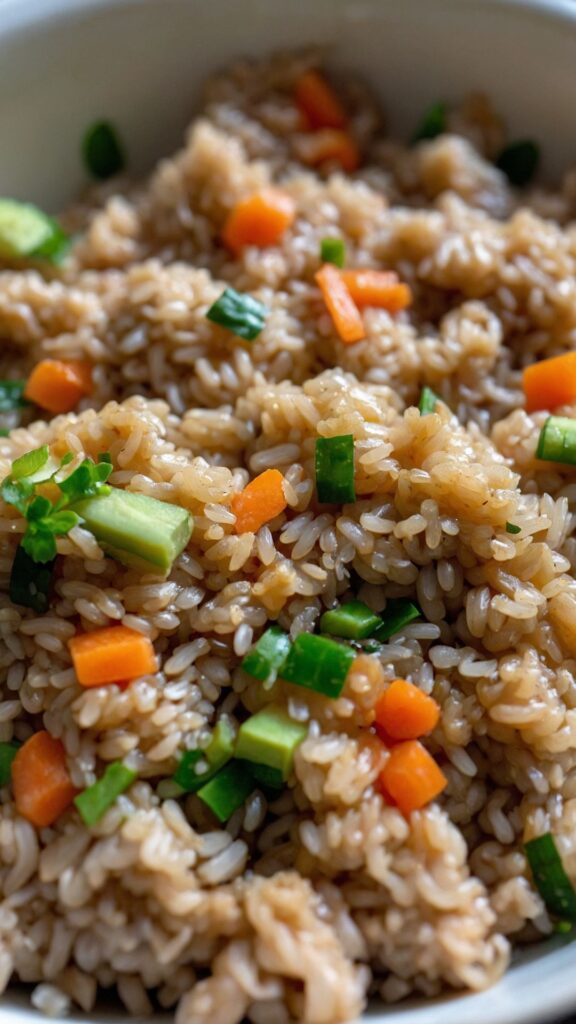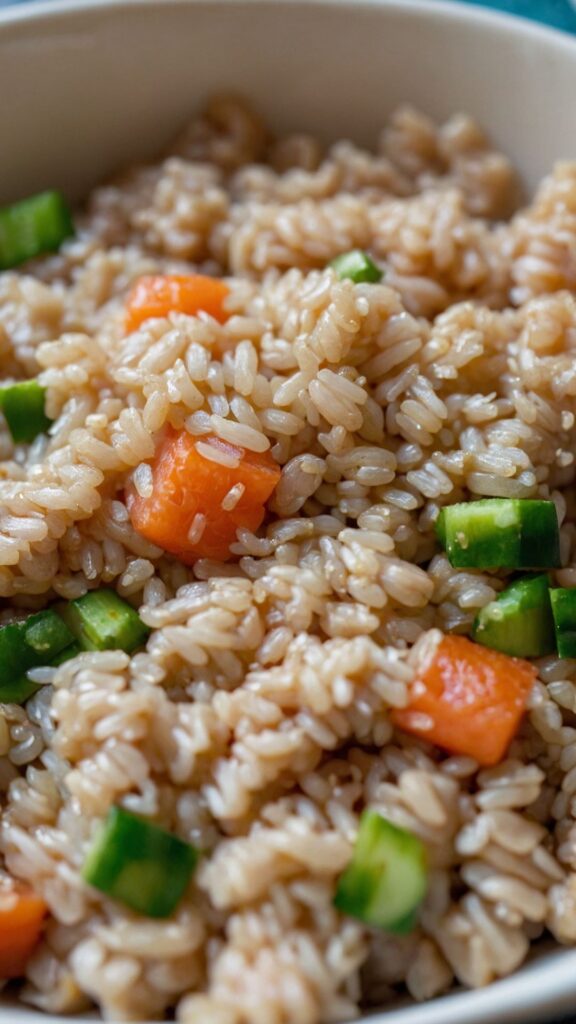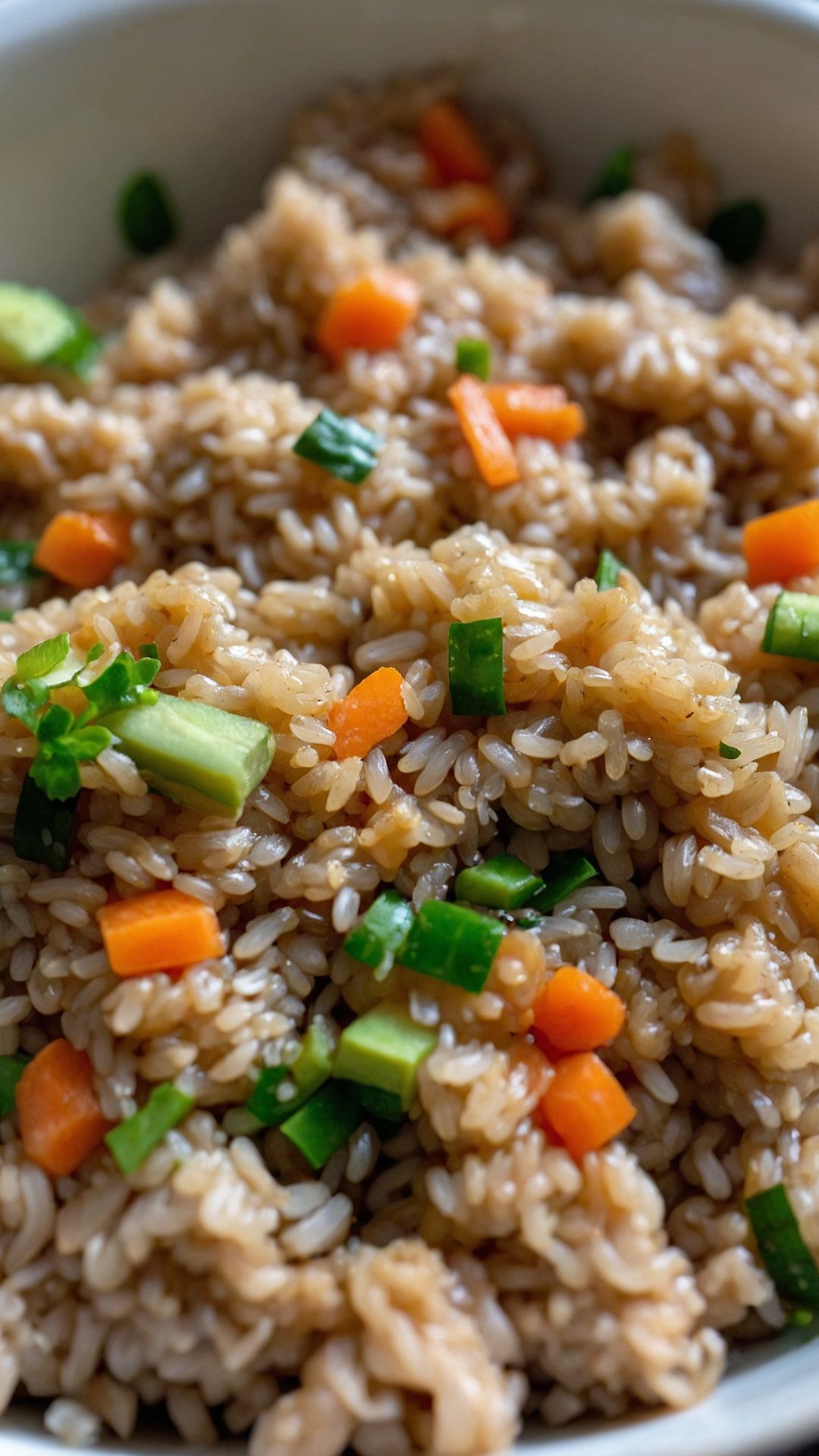Before diving into the depths of brown sushi rice, let’s talk about what goes well with this nutritious grain. Brown sushi rice, with its chewy texture and nutty flavor, pairs wonderfully with many ingredients. Try it with fresh vegetables like cucumber or avocado.
They add crunch and creaminess, balancing the rice’s heartiness. You could also experiment with seafood, like salmon or shrimp, which complement the rice beautifully.
For additional flavor, consider adding a drizzle of sesame oil or a sprinkle of sesame seeds. A splash of soy sauce can elevate the dish further.
If you’re in the mood for something unexpected, mix it with seasoned tofu or even edamame for that extra protein kick. Now that we have those pairings sorted, let’s dive into the world of brown sushi rice!

The Allure of Brown Sushi Rice
I remember the first time I tasted sushi made with brown rice. It was at a trendy little sushi joint in my neighborhood, and I was struck by how different it felt compared to the white rice versions I had tried before.
It had a bite and a flavor that lingered, making each bite an experience rather than just a meal. You see, brown sushi rice is more than just a substitute for white sushi rice. It’s an upgrade. It provides dietary fiber, vitamins, and minerals that give you energy and aid digestion.
As a registered dietitian, I often hear the debates surrounding sushi. Should you eat sushi with white rice or opt for the brown variety?
The answer is always subjective, but I find that brown sushi rice offers all the nostalgic warmth of sushi while adding an extra layer of wholesomeness.
But what exactly is brown sushi rice? Is it simply a brown version of the sushi rice you know? Let’s unpack that.
You will also like the following Side dish recipes!
What is Brown Sushi Rice?
At its core, brown sushi rice is a whole grain variation of the traditional sushi rice. Sushi rice, typically short-grain white rice, is renowned for its sticky texture, which holds the dish together. Brown sushi rice retains the bran and germ that white rice loses during milling.
This means that brown sushi rice packs more nutrients, such as fiber, B vitamins, iron, and magnesium. The grain’s whole state gives each piece an earthy taste and a chewy texture — perfect for sushi rolls or a standalone bowl.
While brown sushi rice requires a little more cooking time than white rice, the results are worth it. Once cooked, it becomes wonderfully sticky, making it ideal for forming sushi rolls.
What is the Flavor Profile of This Dish?
To describe the flavor profile of brown sushi rice, think nutty but enriched by the accompanying ingredients. The rice itself bears an inherent earthiness, which acts as a blank canvas. This canvas allows you to explore different flavors intensely.
When seasoned properly with sushi-su, the seasoned vinegar blend, you create a slight tang and sweetness that balances the grain’s nuttiness.
Moreover, toppings and fillings can create a delightful contrast. For instance, when you couple brown sushi rice with a refreshing cucumber or spicy tuna, you get a medley of flavors that excite your palate.
In essence, brown sushi rice is versatile — it carries flavors while bringing its unique character to the dish.
What Makes This Recipe Different From Other Brown Sushi Rice?
This recipe stands out because it embraces the traditional elements of sushi while offering a healthier base. While many sushi recipes rely on white rice and sugar-laden sauces, this version uses wholesome brown rice and a homemade seasoned vinegar blend.
It takes inspiration from classic sushi practices. The method remains the same, yet the ingredients tell a different story.
You’ll experience complex flavors without compromising your health.
Plus, it caters to those who may have dietary restrictions. Whether you are gluten intolerant or simply trying to eat cleaner, this recipe allows everyone to savor the joys of sushi without guilt.
Ingredients You’ll Need
To craft the perfect brown sushi rice, you’ll need the following ingredients:
Seasoned Vinegar Blend (sushi-su)
4 teaspoons granulated sugar
2 teaspoons fine sea salt
100 ml seasoned rice vinegar
1 teaspoon kombu
1 teaspoon mirin
Short-Grain Whole Grain Rice
1 small pinch of sea salt
380 g whole grain brown rice (uncooked)
750 ml filtered water (for both soaking and cooking)
These ingredients combine to create a delightful sticky rice that’s perfect for sushi rolls or as a flavorful side dish.

Step by Step Directions
Let’s get cooking! Here’s how to prepare delicious brown sushi rice.
Step 1: Rinse the Brown Rice
Start by measuring out the 380 grams of brown rice. Rinse it under cold water. This step removes excess starch and prevents the rice from becoming overly gooey when cooked.
You want the grains to stay separate while maintaining that glorious chewiness.
Step 2: Soak the Rice
After rinsing, place the rice into a bowl and cover it with filtered water. Soak it for about 30 minutes. Soaking allows the rice to absorb water before cooking, which leads to a tender texture.
Step 3: Cook the Rice
Drain the soaked rice and transfer it to a rice cooker or a pot. Add 750 ml of fresh water and a small pinch of salt. If you’re using a rice cooker, follow the manufacturer’s instructions.
If cooking on the stove, cover the pot, bring the water to a boil, then lower the heat and simmer for about 40-45 minutes, or until the water is absorbed and the rice is tender.
Step 4: Prepare the Sushi-su
While the rice is cooking, combine the granulated sugar, fine sea salt, seasoned rice vinegar, kombu, and mirin in a small saucepan.
Heat over low heat, stirring until sugar and salt dissolve. Remove from heat and let it cool. This balanced blend is crucial for flavoring your rice later.
Step 5: Mix the Rice with Sushi-su
Once your rice is cooked, transfer it to a large bowl or a wooden sushi tub. Pour the prepared sushi-su over the warm rice. Gently fold the rice using a wooden paddle or spatula, being careful not to mash the grains. Aim for a cutting motion. Let the rice cool to room temperature before using it in your sushi.
Step 6: Assemble Your Sushi
Now that you have prepared brown sushi rice, it’s time to assemble your sushi. Use nori sheets, fresh vegetables, or your favorite fillings.
Roll tightly and slice to your desired thickness. Enjoy with soy sauce or your dipping sauce of choice.
Tips On Making Brown Sushi Rice
Here are some handy tips to ensure your brown sushi rice turns out perfectly every time:
- Use the Right Rice: Always choose short-grain brown rice for that sticky texture. You can find it at most grocery stores or health food stores.
- Don’t Skip Soaking: Soaking rice is critical. It softens the grains and leads to better cooking results.
- Keep It Covered: While cooking, make sure you keep the pot covered. This helps create steam, which is essential for cooking the rice evenly.
- Let It Cool: Once seasoned, allow the rice to cool to room temperature before using it for sushi. This step keeps the rice from wilting other ingredients.
- Experiment with Seasoning: Feel free to adapt the sushi-su. Add a bit of citrus zest or a drop of sesame oil for a flavor upgrade.
Nutrition Information
Brown Sushi Rice Recipe Nutrition Facts
How Can I Store This Brown Sushi Rice?
If you’ve made more rice than you need, storing it correctly is key:
- In the Fridge: Store any leftover brown sushi rice in an airtight container in the refrigerator. It should keep fresh for up to 3 days.
- Freezing: For longer storage, spread the rice on a baking sheet to cool completely. Once cooled, transfer portions to freezer bags and freeze. This rice can be frozen for up to 3 months. When you’re ready to eat, simply thaw it overnight in the fridge and reheat.

Substitute Options for the Ingredients
Sometimes you might find yourself missing a key ingredient. If that’s the case, here are some helpful substitutes:
- Brown Rice: Quinoa is excellent. It has a similar nutty flavor profile with a slightly different texture but still offers that wholesome bite.
- Seasoned Rice Vinegar: Apple cider vinegar mixed with a bit of sugar can work. It won’t taste identical but provides acidity with a gentle sweetness.
- Kombu: If you can’t find kombu, kelp flakes can serve as a substitute. It offers a similar umami flavor.
- Mirin: For a mirin replacement, try using white wine vinegar mixed with a hint of honey. This gives you that sweet yet tart flavor you need.

Equipment
- Pot
Ingredients
Seasoned Vinegar Blend (sushi-su)
- 4 teaspoons granulated sugar
- 2 teaspoons fine sea salt
- 100 ml seasoned rice vinegar
- 1 teaspoon kombu
- 1 teaspoon mirin
Short-Grain Whole Grain Rice
- 1 small pinch of sea salt
- 380 g whole grain brown rice uncooked
- 750 ml filtered water for both soaking and cooking
Instructions
Step 1: Rinse the Brown Rice
- Start by measuring out the 380 grams of brown rice. Rinse it under cold water. This step removes excess starch and prevents the rice from becoming overly gooey when cooked.
- You want the grains to stay separate while maintaining that glorious chewiness.
Step 2: Soak the Rice
- After rinsing, place the rice into a bowl and cover it with filtered water. Soak it for about 30 minutes. Soaking allows the rice to absorb water before cooking, which leads to a tender texture.
Step 3: Cook the Rice
- Drain the soaked rice and transfer it to a rice cooker or a pot. Add 750 ml of fresh water and a small pinch of salt. If you’re using a rice cooker, follow the manufacturer’s instructions.
- If cooking on the stove, cover the pot, bring the water to a boil, then lower the heat and simmer for about 40-45 minutes, or until the water is absorbed and the rice is tender.
Step 4: Prepare the Sushi-su
- While the rice is cooking, combine the granulated sugar, fine sea salt, seasoned rice vinegar, kombu, and mirin in a small saucepan.
- Heat over low heat, stirring until sugar and salt dissolve. Remove from heat and let it cool. This balanced blend is crucial for flavoring your rice later.
Step 5: Mix the Rice with Sushi-su
- Once your rice is cooked, transfer it to a large bowl or a wooden sushi tub. Pour the prepared sushi-su over the warm rice. Gently fold the rice using a wooden paddle or spatula, being careful not to mash the grains. Aim for a cutting motion. Let the rice cool to room temperature before using it in your sushi.
Step 6: Assemble Your Sushi
- Now that you have prepared brown sushi rice, it’s time to assemble your sushi. Use nori sheets, fresh vegetables, or your favorite fillings.
- Roll tightly and slice to your desired thickness. Enjoy with soy sauce or your dipping sauce of choice.
Notes
- Use the Right Rice: Always choose short-grain brown rice for that sticky texture. You can find it at most grocery stores or health food stores.
- Don’t Skip Soaking: Soaking rice is critical. It softens the grains and leads to better cooking results.
- Keep It Covered: While cooking, make sure you keep the pot covered. This helps create steam, which is essential for cooking the rice evenly.
- Let It Cool: Once seasoned, allow the rice to cool to room temperature before using it for sushi. This step keeps the rice from wilting other ingredients.
- Experiment with Seasoning: Feel free to adapt the sushi-su. Add a bit of citrus zest or a drop of sesame oil for a flavor upgrade.
Nutrition
Frequently Asked Questions
1. Is brown sushi rice gluten-free?
Yes, brown sushi rice is naturally gluten-free. It comes from rice grains, making it a safe choice for those with celiac disease or gluten sensitivity.
Always double-check any added seasoning or sauces for gluten.
2. Can I use brown sushi rice for sushi rolls?
Absolutely! Brown sushi rice adapts beautifully to sushi rolls. Its sticky texture helps hold everything together just like traditional white sushi rice. You can have fun experimenting with various fillings!
3. How does brown sushi rice differ in preparation from white sushi rice?
The main difference lies in the cooking time and soaking requirement. Brown sushi rice needs more time to cook and benefits from soaking, while white rice cooks faster and doesn’t require soaking.
4. Can I make sushi with cooked brown rice?
Yes! You can use pre-cooked brown rice to make sushi rolls. Ensure the rice is warm while rolling to help it stick together. The flavor profile may differ slightly, but the dish remains delicious.
5. How can I enhance the flavor of brown sushi rice?
Use broth instead of water while cooking for added depth.
Mix in sautéed garlic or ginger, which can bring a subtle kick.
Experiment with additional seasonings and herbs that resonate with your taste preferences.
Conclusion
Brown sushi rice is a delightful alternative that not only nourishes but also enriches your sushi experience. The flavor, texture, and health benefits make it a standout option.
You can whip up this delicious recipe in no time, and the result will impress friends and family. Plus, it’s all about exploring flavors and enjoying food in a healthier way!
So, whether you’re making sushi for a special occasion or just want a fun dinner idea, brown sushi rice might become your new kitchen staple. Happy cooking, and don’t forget to get creative with your toppings and fillings!
